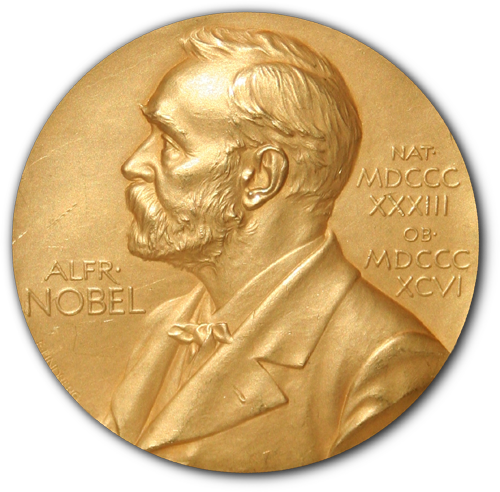

Every May for the past 10 years, Thomson Reuters analyst David Pendlebury has sat down and pored through academic papers, searching for a glimmer of glory. On the hunt for scientists who deserve a Nobel Prize, Pendlebury sifts through papers on topics from macroeconomics to macromolecules, judging their influence on their respective fields and choosing scientists whose work stands the test of time. PopSci talked to him about his methodology — the science behind predicting the science Nobel winners.
Pendlebury’s picks include physics, chemistry, physiology/medicine, and economics — the Nobels for science, whose impact can be measured. Peace and literature are somewhat more subjective. Pendlebury begins with academic citations, he explained in an interview. Thomson Reuters is the only group to predict Nobel winners based on data, not just a bookie’s odds, and has been quite accurate so far, correctly picking 26 recipients in the past decade. Last year, every single winner was previously predicted, either in 2008 or 2010.
Sometimes Nobel Prize winners are easy to spot; Francis Crick and James Watson, for instance, whose DNA-structure Nobel is 50 years old this year, were shoo-ins for an eventual win. But sometimes there are sleepers, and sometimes a victory comes fast on the heels of a finding, like Andre Geim’s and Konstantin Novoselov’s 2010 win for six-year-old papers on graphene. And, of course, sometimes there are snubs.
“We pay particular attention to highly cited papers, which are the rare birds in research,” Pendlebury said. “The data so clearly emphasize which few people are at the top end of that distribution. It’s like looking at a peak of a mountain — it’s easy to see, sticking out right there at the top.”
But the mountaintops have to form first. Often, decades of work must bolster original research before it’s clear that its author is worthy of a Nobel Prize. The Nobel Committee chooses winners based on nominations and peer review; Pendlebury finds candidates by searching Thomson Reuters’ journal article database, called the Web of Knowledge. Academics can use it to find scholarly articles of interest to them. Among a wealth of searchable data, it correlates papers with others that have referenced them, providing insight on a paper’s impact, Pendlebury said. “Papers that are cited a lot are influential, or at least have utility. We do not claim that high citations equal quality — that is a human judgment,” he said. “But there is a strong correlation between high citations and the people who end up getting Nobel Prizes.”
Armed with well-cited and well-regarded papers, Pendlebury moves on to an analysis of the field. He’ll study topics like epigenetics or welfare economics and ensure the mountaintop researchers really are the pioneers in that field. Then he’ll study the field itself — is this something that counts as a major breakthrough in physics, chemistry, medicine or economics, and if so, has a researcher in this field won a Nobel in the past? Finally, he’ll look at other citations, including some specialist awards that tend to foreshadow the Nobels. If all these criteria are met and the scientist in question is still living, he or she will make Pendlebury’s list. He wraps up the process by September.

“We are not saying the people whose names we are putting forth this year will win this year — we actually have done that before, but we’re not trying to do that. We’re trying to recognize the Nobel-class people,” he said. “The people we’ve named in previous years, we think, are as good of contenders.”
This year’s citation laureates include two researchers who published pioneering work on genetic regulation, which Pendlebury thinks is ripe for a prize. In economics, he cited two economists who have studied income inequality and poverty, an important political topic throughout Europe and in the U.S. in the past year. In physics, Pendlebury calls out quantum teleportation, but not the Higgs boson, noting the Nobel committee has historically been conservative in recognizing new breakthroughs.
The graphene winners are one exception to that rule — and one Pendlebury correctly predicted. Geim and Novoselov published their original papers in 2004 and 2005, so if the Nobel committee followed past trends, it would be a while yet before they’d be acknowledged — in physics, the average time from publication to prize is 25 years. “But it was clear from the rapid accumulation of citations of those papers that this was really an exceptional discovery,” Pendlebury said. He cited them as Nobel-quality citation laureates in 2008. They won in 2010.
Pendlebury said he’ll set an alarm for 2 a.m. Pacific time Monday morning, when the prize for physiology or medicine will be announced. Physics and chemistry follow the next two days, peace is on Friday and the following Monday, Oct. 15, is economics.
He said he makes predictions to demonstrate that citations are a clear indicator of a particular paper’s value to scientists — but it’s more than that. “We also do it because we want to give recognition and honor to the scientists who have achieved the highest level,” he said. “There are so few Nobel Prizes given out, relative to the people who are in a position to win them.”
You can read Pendlebury’s full list here.
